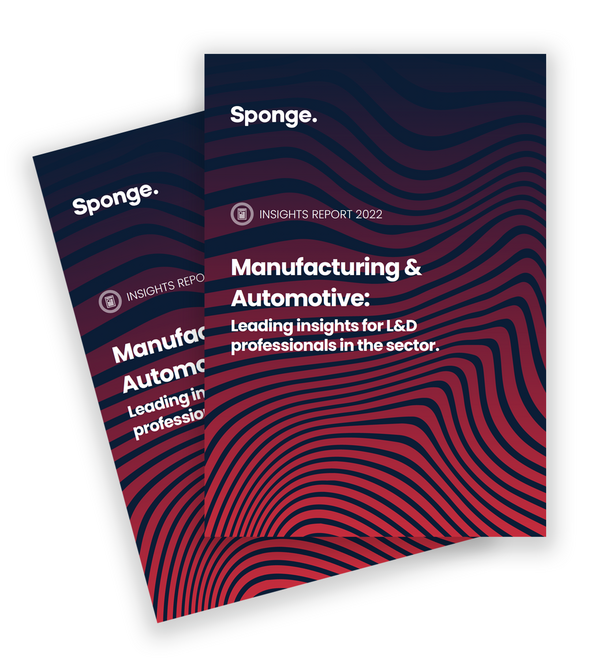What are the top 3 insights for L&D in the manufacturing and automotive industry?

In the third of five industry reports following Learning Technologies 2022, we turn our attention to the manufacturing and automotive sector. This blog looks at the three ways that L&D can capitalise on the sector’s growth post-COVID-19 and support the transition to ‘Industry 4.0’.
Setting the scene.
The pandemic wreaked havoc on the manufacturing and automotive industry. However, following the vaccine roll-out, the industry has witnessed a surge in consumer demand and is predicted to grow by 4.1% in 2022.
Obviously this growth is good news, but it does not mean the future will be plain sailing for the sector. Historical labour shortages will have to be overcome and many in the industry will need to further their technological capabilities, in response to the so-called Fourth Industrial Revolution or ‘Industry 4.0’.
The industry should embrace learning and development as a way of meeting its short and long-term needs. However, this is no easy feat – given the sector’s traditional reluctance to embrace training.
Across the following three insights, gathered from critical conversations at Learning Technologies 2022, we assess how L&D can secure the sector’s future by tackling its onboarding issues, customer experience, and upskilling needs head-on. These insights are summarised in the following blog and explored in more detail in the downloadable insights report, below.
Insight One: Onboarding & retaining talent remains a key sector challenge.
A perfect storm of issues has created large-scale employment gaps within the manufacturing and automotive sector. Firstly, the industry has an unusually high average age – nearly 50% of the US manufacturing workforce is over 45; 25% is over 55. Secondly, the Great Resignation means that many have left a sector with traditionally inflexible working practices, which are not suited to the expectations of post-COVID-19 workers.
In July 2021, US manufacturing vacancies soared to a record of 906,000. Clearly, something needs to change, with L&D playing a critical role in attracting and retaining new manufacturing and automotive talent.
Whether its employers clearly promoting learning opportunities when advertising a role, putting their new recruits through a thorough onboarding process, or offering continuous development, L&D is vital in providing a long-term solution to this issue.
Insight Two: Personalising the customer experience will result in stronger brand loyalty.
Supply chain issues brought on by COVID-19 led manufacturers to simplify and streamline their processes. This, in turn, has meant that key players in the manufacturing and automotive sector are now better placed to deliver a highly personalised service to consumers.
Personalisation has become an important driver of business growth – 80% of customers say they are likely to do business with an organisation that offers a highly personalised service. Consequently, L&D can play a major role in ensuring employees learn the necessary personalisation skills, and that this learning ‘sticks’. At the same time, there must be an awareness that consumer requirements will always be shifting, meaning that L&D should be connected to marketing and sales and respond to external changes.
Soft skills are vitally important for supporting interpersonal relationships, and Sponge’s Skill Pill micro-learning offers a range of titles on selling, negotiating, and verbal and non-verbal communication that can help employees deliver a more personalised experience. L&D practitioners should also look beyond off-the-shelf content. For example, mentoring schemes and user-generated content can be excellent ways to share best practice when it comes to sales.
Insight Three: Workforce upskilling is critical to capitalising on technological change.
The so-called Fourth Industrial Revolution is drastically shaking up manufacturing processes with several innovations, including AI, VR, and machine learning. Running in tandem with this digital transformation is the need to upskill all employees.
L&D must be a driving force in looking beyond the futuristic, to take a holistic approach to upskilling in the here and now. In turn, this upskilling will lead to a redefining of manufacturing and automotive roles as ‘skilled’ and therefore have the added benefit of drawing a more diverse range of talent into the sector.
L&D should also be looking to embrace this new tech to upskill its workforce. For example, given the use of expensive, potentially dangerous equipment, practitioners should consider using Virtual Reality (VR) and Augmented Reality (AR) to rapidly train large numbers of employees simultaneously.
Although initially expensive, these types of content deliver an excellent ROI and can be used to teach both hard and soft skills. They are therefore an important tool in an L&D practitioner’s arsenal for future-proofing an organisation in the manufacturing and automotive sector.
How can Sponge help?
Sponge has over ten years’ experience delivering quality learning programmes to a range of large manufacturing and automotive organisations, including Tetra Pak, The International Powered Access Federation (IPAF), and Toyota. We are experts in onboarding and talent retention, have a wealth of content to offer on boosting personalisation, and are future-focused thought leaders, capable of developing roadmaps that meet the sector’s digital needs head-on.
Author: Beth Chudley, Learning Experience Consultant, Sponge
Download report
For a deeper analysis of the insights we discuss, take a look at our third industry-specific report.
In this report, we will cover:
- An analysis of the top 3 L&D insights for the manufacturing and automotive sector.
- Key considerations when addressing these priority areas.
- How to set your digital learning up for success.
